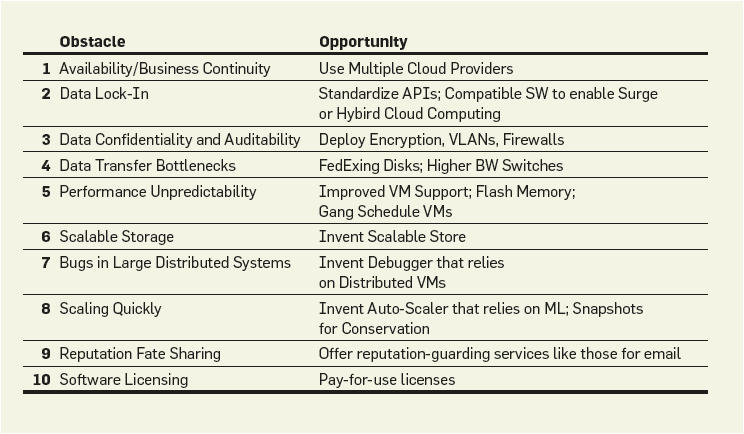In this article we will look at 10 Obstacles and Opportunities for Cloud Computing.
According to [1] following are the top ten obstacles for cloud computing:
Contents
- 1 Obstacle 1: Business Continuity and Service Availability
- 2 Obstacle 2: Data Lock-In
- 3 Obstacle 3: Data Confidentiality/Auditability
- 4 Obstacle 4: Data Transfer Bottlenecks
- 5 Obstacle 5: Performance Unpredictability
- 6 Obstacle 6: Scalable Storage
- 7 Obstacle 7: Bugs in Large-Scale Distributed Systems
- 8 Obstacle 8: Scaling Quickly
- 9 Obstacle 9: Reputation Fate Sharing
- 10 Obstacle 10: Software Licencing
Obstacle 1: Business Continuity and Service Availability
Organizations often worry about the availability of the service provided by the cloud providers. Even the popular service providers like Amazon, Google, Microsoft experience outages. Keeping the technical issues of a availability aside, a cloud provider could suffer outages for non-technical reasons like going out of business or regulatory action.
Obstacle 2: Data Lock-In
Data Lock-is related to tight dependency of an organization’s business with the software or hardware infrastructure of a cloud provider. Even though software stacks have improved interoperability among platforms, the storage APIs are still essentially proprietary, or at least have not been subject of active standardization. This leads to customers not being able to extract their data and programs from one site to run on another as in hybrid cloud computing or surge computing.
Obstacle 3: Data Confidentiality/Auditability
Security of sensitive information in the cloud is one of the most often cited objections to cloud computing. Analysts and skeptical companies ask “who would trust their essential data out there somewhere?”. Cloud users face security threats both from outside and inside the cloud.
The cloud user is responsible for application-level security. The cloud provider is responsible for physical security, and likely for enforcing external firewall policies. Security for intermediate layers is shared between the user and the operator.
Although cloud makes external security easier, it does pose new problems related to internal security. Cloud providers must guard against theft or denial-of-service attacks by users. Users need to be protected from one another.
Obstacle 4: Data Transfer Bottlenecks
Now-a-days cloud applications are becoming data-intensive. The data store capacity of enterprise applications or academic scientific programs might range from a few terabytes to a few petabytes or even more.
Transferring such high volumes of data between two clouds might take from a few days to even months with network having high data rates.
Obstacle 5: Performance Unpredictability
In the cloud virtual machines can share CPUs and main memory effectively but network and I/O sharing is more problematic. As a result, different Amazon EC2 instances vary more in their I/O performance than in main memory performance.
The obstacle to attracting HPC is, HPC applications need to ensure that all the threads of a program are running simultaneously, and today’s virtual machines and operating systems do not provide a programmer visible way to ensure this.
Obstacle 6: Scalable Storage
The problem with storage is it’s rigid behavior towards scalability. There have been many attempts to answer this, varying in the richness of the query and storage APIs, the performance guarantees offered, and the resulting consistency semantics.
Obstacle 7: Bugs in Large-Scale Distributed Systems
One of the difficult challenges in cloud computing is removing errors in large-scale distributed systems. A common caveat is that these bugs cannot be reproduced in smaller configurations, so the debugging must occur at scale in the production data centers.
Obstacle 8: Scaling Quickly
Pay-as-you-go model is well applied for storage and network bandwidth, as they can be measured in terms of bytes transferred. Computation is slightly different, depending on the virtualization level. For example, Google AppEngine automatically scales in response to load increases and decreases, and users are charged by the cycles used. AWS charges by the hour for the number of instances that are alive (even when they are inactive).
Obstacle 9: Reputation Fate Sharing
One customer’s bad behavior can affect the reputation of other customers using the same cloud. For example, In March 2009, FBI raided a Dallas data center because a company whose services are hosted there was being investigated for possible criminal activity, which affected a number of other innocent customers who are also hosted in the same data center.
Obstacle 10: Software Licencing
Current software licencing bills its consumers on the basis of how many machines (physical) on which the software is going to be installed. The problem with cloud is, the computational units are VMs instead of physical machines. A physical machine might have tens of VMs running on it. So, how does software vendors licence their software?
Following table gives a summary of the above mentioned obstacles for cloud computing along with possible opportunities for each obstacle:
References
[1] M. Armbrust, I. Stoica, M. Zaharia, A. Fox, R. Griffith, A. D. Joseph, R. Katz, A. Konwinski, G. Lee, D. Patterson, and A. Rabkin, “A view of cloud computing,” Commun. ACM, vol. 53, no. 4, pp. 50–58, 2010.
Suryateja Pericherla, at present is a Research Scholar (full-time Ph.D.) in the Dept. of Computer Science & Systems Engineering at Andhra University, Visakhapatnam. Previously worked as an Associate Professor in the Dept. of CSE at Vishnu Institute of Technology, India.
He has 11+ years of teaching experience and is an individual researcher whose research interests are Cloud Computing, Internet of Things, Computer Security, Network Security and Blockchain.
He is a member of professional societies like IEEE, ACM, CSI and ISCA. He published several research papers which are indexed by SCIE, WoS, Scopus, Springer and others.


Leave a Reply